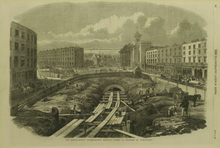History

The opening of London's steam-hauled Metropolitan Railway in 1863 marked the beginning of rapid transit. Initial experiences with steam engines, despite ventilation, were unpleasant. Experiments with pneumatic railways failed in their extended adoption by cities. Electric traction was more efficient, faster and cleaner than steam and the natural choice for trains running in tunnels and proved superior for elevated services.
In 1890 the City & South London Railway was the first electric-traction rapid transit railway, which was also fully underground. Prior to opening the line was to be called the "City and South London Subway", thus introducing the term Subway into railway terminology. Both railways, alongside others, were eventually merged into London Underground. The 1893 Liverpool Overhead Railway was designed to use electric traction from the outset.
The technology quickly spread to other cities in Europe, the United States, Argentina, and Canada, with some railways being converted from steam and others being designed to be electric from the outset. Budapest, Chicago, Glasgow and New York all converted or purpose-designed and built electric rail services.
Advancements in technology have allowed new automated services. Hybrid solutions have also evolved, such as tram-train and premetro, which incorporate some of the features of rapid transit systems. In response to cost, engineering considerations and topological challenges some cities have opted to construct tram systems, particularly those in Australia, where density in cities was low and suburbs tended to spread out. Since the 1970s, the viability of underground train systems in Australian cities, particularly Sydney and Melbourne, has been reconsidered and proposed as a solution to over-capacity. The first rapid transit line in Australia was opened in Sydney in 2019, which will feed into a larger network known as the Sydney Metro upon completion of a second line in 2024.
Since the 1960s many new systems were introduced in Europe, Asia and Latin America. In the 21st century, most new expansions and systems are located in Asia, with China becoming the world's leader in metro expansion operating some of the largest and busiest systems while possessing almost 60 cities operating, constructing or planning a rapid transit system.
Comments
Post a Comment